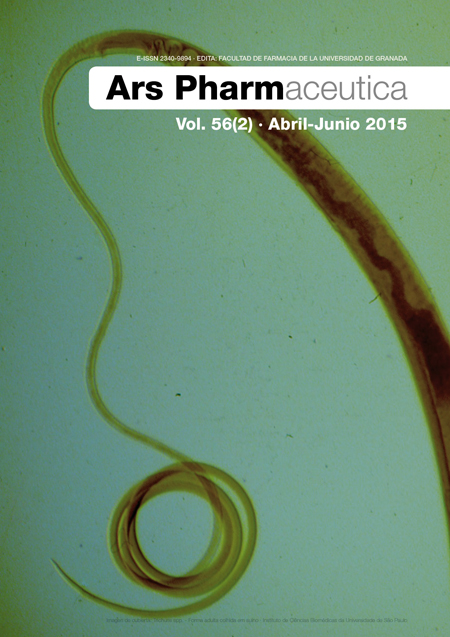Prescribing pattern of antihypertensive drugs in diabetic patients of Southern Province, Kingdom of Saudi Arabia
DOI:
https://doi.org/10.4321/s2340-98942015000200005Keywords:
Hypertension, Diabetes, Antihypertensive agentsAbstract
Background. Hypertension is extremely prevalent in patients with diabetes. Limited data exist on utilizationpatterns of antihypertensive in this population are consistent with evidence-based practice guidelines.
Objective. To evaluate utilization patterns of antihypertensive agents among diabetic patients with hypertension.
Design. Retrospective descriptive cross sectional.
Patients / Participants. 149 patients with diabetes and hypertension from outpatient department at FamilyMedicine Hospital, Ahaderfieda. Khamis Mushait, K.S.A.
Results. Over 43% of patients were receiving calcium channel blockers (CCB), 36.2 % of received angiotensinconverting enzyme inhibitors (ACEI), followed by angiotensin receptor blockers (ARBs) (34.9%),diuretics (34.2%) and β -blockers (16.2%). Patients on monotherapy were mostly receiving CCB (34.3%)and ACEI (29.9%). The majority (55.03%) of treated patients were on multidrug regimens. In patientswith coronary artery disease (CAD), a diuretic with ACEI (25%) and calcium channel blocker with angiotensinreceptor blocker (25%) was most commonly prescribed.
Conclusions. Patterns of antihypertensive therapy were generally consistent with international guidelines.Areas of improvement include increasing ACEI/ARB and diuretic use, decreasing the number ofuntreated patients, and increasing the proportion of patients with controlled BP in this population.
Downloads
References
El-Hazmi MA, Warsy AS. Association of hypertension and
non-insulin-dependent diabetes mellitusin the Saudi population.
Ann Saudi Med. 2001; 21(1-2):5-8.
Al-Baghli NA, Al-Ghamdi AJ, Al-Turki KA, Al Elq AH, El-
Zubaier AG, Bahnassy A. Prevalence of diabetes mellitus
and impaired fasting glucose levels in the Eastern Province
of Saudi Arabia: results of a screening campaign. Singapore
Med J. 2010; 51(12):923-30.
Preliminary Report on the Results of Monitoring of Risk Factors
for Non-Communicable Diseases in the Kingdom of Saudi
Arabia. Riyadh: King Fahad National Library; 2005.
Dhanaraj E, Raval A, Yadav R, Bhansali A, Tiwari P. Prescription
Pattern of Antihypertensive Agents in T2DM Patients
Visiting Tertiary Care Centre in North India. Int J Hypertens.
; 2012:520915. doi: 10.1155/2012/520915.
Chobanian AV et al.. The Seventh Report of the Joint National
Committee on Prevention, Detection, Evaluation, and Treatment
of High Blood Pressure: the JNC 7 report. JAMA. 2003;
(19):2560-72.
Shah J, Khakhkhar T, Bhirud S, Shah RB, Date S. Study of utilization pattern of anti-hypertensive drugs in hypertensive
diabetic patients with or without reduced renal function at tertiary care teaching hospital. Int J Med Sci Public Health. 2013; 2(2): 175-180.
Berlowitz DR1, Ash AS, Hickey EC, Glickman M, Friedman R, Kader B. Hypertension management in patients with diabetes: the need for more aggressive therapy. Diabetes Care. 2003; 26(2):355-9.
Saudi Hypertension Management Guidelines, Saudi Hypertension
Management Society, 2011.
Arauz-Pacheco C1, Parrott MA, Raskin P.The treatment of
hypertension in adult patients with diabetes. Diabetes Care. 2002; 25(1):134-47.
Sowers JR, Haffner S. Treatment of cardiovascular and renal risk factors in the diabetic hypertensive. Hypertension 2002; 40:781-8.
Sowers JR, Reed J. 1999 Clinical Advisory Treatment of Hypertension and Diabetes. J Clin Hypertens (Greenwich) 2000;
:132-3.
Sharminder Kaur S , Gupta S , Kumar D , Lal M , Gilani Z. Prescribing pattern of antihypertensive drugs in a tertiary care hospital in Jammu- A Descriptive study. JK-Practitioner 2012; 17 (4): 38-41.
The Seventh Report of the Joint National Committee on Prevention,
Detection, Evaluation, and Treatment of High Blood Pressure. National High Blood Pressure Education Program. Source Bethesda (MD): National Heart, Lung, and Blood Institute (US); 2004. Report No.: 04-5230.
Fox KM ; EURopean trial On reduction of cardiac events with
Perindopril in stable coronary Artery disease Investigators. Efficacy of perindopril in reduction of cardiovascular events among patients with stable coronary artery disease: randomised, double-blind, placebo-controlled, multicentre trial (the EUROPA study).Lancet. 2003; 362 (9386):782-8.
McAlister FA, Campbell NR, Duong-Hua M, Chen Z, Tu K.
Antihypertensive medication prescribing in 27,822 elderly Canadians with diabetes over the past decade. Diabetes Care.
; 29(4):836-41.
Richards M. The Safety of Calcium Antagonists: An Update. Prescriber Update. 2000; 19: 4–13.
Wald DS, Law M, Morris JK, et al.. Combination therapy versus
monotherapy in reducing blood pressure: meta-analysis on 11,000 participants from 42 trials. Am J Med. 2009; 122:290-300.
Vogel Anderson KL, Combination Therapy in Hypertension Management. US Pharm. 2012; 37(6):46-50.
Kale A, Maniyar YA. Prescribing patterns of antihypertensive drugs in a tertiary care hospital. Sch Acad J Pharm. 2013; 2(5):416-418.
Gu Q, Burt VL, Dillon CF, Yoon S. Trends in antihypertensive
medication use and blood pressure control among United States adults with hypertension: the National Health and Nutrition Examination Survey, 2001 to 2010. Circulation. 2012; 126(17):2105-14.
Skolnik NS, Beck JD, Clark M. Combination antihypertensive drugs: recommendations for use. Am Fam Physician. 2000; 61(10):3049-56.
Escobar C, Barrios V. Calcium channel blocker-based combination
therapy. The best approach in the treatment of highrisk hypertension? Int J Clin Pract. 2008; 62(5):670-2.
Kalra S, Kalra B, Agrawal N. Combination therapy in hypertension:
An update. Diabetol Metab Syndr. 2010; 2(1):44. doi: 10.1186/1758-5996-2-44.
Downloads
Published
How to Cite
Issue
Section
License
The articles, which are published in this journal, are subject to the following terms in relation to the rights of patrimonial or exploitation:
- The authors will keep their copyright and guarantee to the journal the right of first publication of their work, which will be distributed with a Creative Commons BY-NC-SA 4.0 license that allows third parties to reuse the work whenever its author, quote the original source and do not make commercial use of it.
b. The authors may adopt other non-exclusive licensing agreements for the distribution of the published version of the work (e.g., deposit it in an institutional telematic file or publish it in a monographic volume) provided that the original source of its publication is indicated.
c. Authors are allowed and advised to disseminate their work through the Internet (e.g. in institutional repositories or on their website) before and during the submission process, which can produce interesting exchanges and increase citations of the published work. (See The effect of open access).























